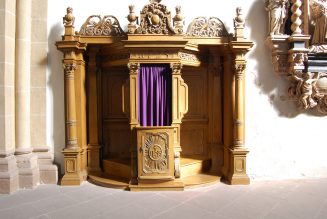
The notion that someone would view the death of a human being as liberating may sound strange, but depending on the context of how the person died, I argue it would be cause for celebration. The irony here is that death as a liberating gift is precisely what Jesus Christ did when he entered Jerusalem to prepare for his crucifixion. The significance of his entrance into the holy city is Jesus’ preparation to carry our sins and destroy them by his sacrificial death. As a result of his crucifixion, the sting of death is destroyed; the gates of heaven are opened as paradise awaits those who choose to follow Jesus Christ. Death is no longer a finality but a beginning. Hence, those who had passed before the death of Christ faithfully living the law of God and preaching the coming of the Messiah now embark on their final journey to be with God the Father in heaven for all eternity.
The Catechism of the Catholic Church reminds us that Jesus, like all men, experienced death and, in his soul, joined the others in the realm of the dead. But he descended there as Savior, proclaiming the Good News to the spirits imprisoned there.[1] Those who had been deprived of the vision of God will now see and experience the Glory of God through the Son, Jesus Christ. Jesus descended to free the just who had gone before him. Christ went down into the depths of death so that the dead would hear the voice of the Son of God, and those who hear will live.[2]
I Choose Christ over Sin
Our spiritual progression from the crucifixion to the resurrection is specifically structured to help you, and I willingly proclaim: “I love you more, Lord Jesus, than my sins.” Our Christian faith’s entire spiritual and moral development is publicly revealed when we renew our baptismal promises during the Easter liturgy. An important sequence of our baptismal promises focuses on the rejection of Satan-sin and all his empty works and promises. This sequence of “I do” responses also indirectly asks, “Will you love me more than yourself?”
The Easter event publicly proclaims that Jesus Christ is Lord, Savior, and King who conquers sin and death and destroys the works of the Devil. As mentioned, death is no longer a so-called death sentence into the depths of hell. Death is now intimately connected with the Paschal Mystery affording those who choose Jesus over their sins to be with Him in paradise for all eternity.
The journey of any Catechumen or Candidate who enters the catechumenal process through the Order of Christian Initiation for Adults (OCIA) involves renouncing his old ways of living and viewing God. The intention is to seek a clear, loving, intimate relationship with Jesus Christ where the thought and desire for Christ are primary, to sin is secondary.
A Mystagogical Journey
Participation in the Easter liturgy ushers in the mystagogical journey associated with the life, death, and resurrection of Jesus Christ. The significance of this period for all Catholics is an emphasis on viewing the world through a Catholic lens. Neophytes shed their previous worldview and, through the grace of the sacraments, now begin to view the world through a new Catholic lens. For all of us fortunate to be baptized into the Church at infancy, we received the opportunity to renew our view of the world through the eyes of Jesus Christ.
St. Paul’s letter to the Colossians provides proper context that we should view and live within the world through the eyes of Christ, where he proclaims to do everything from above and not below.[3] If we choose to unite our human faculties with the Son of God with an eye toward heaven and not toward hell, then I argue that our relationship with Jesus begins to make more sense. How? Our desire to communicate with Jesus matures and develops as a necessity rather than a chore. Prayer is no longer viewed as a hindrance but is now embraced and strengthened through a renewed sense of faith. Jesus is no longer a stranger in my life; he is my Lord, and I love him.
The Road to Pentecost
Our Road to Pentecost may be summed up with the following question: how has my view of Jesus changed after the resurrection? The premise of this question can be traced to our baptismal promises, specifically, our public profession of faith in Jesus Christ and our renunciation of sin and the Devil.
The journey to Pentecost involves docility of the spirit, taking each day as a surrender to the will of God our Father and seeking to grow and mature with His son Jesus Christ as the way, the truth, and the light.[4] The Holy Spirit takes center stage during our journey to Pentecost as the advocate for our soul to be more united with Jesus guiding us through our daily surrender to the Divine will over our own human will. The hopeful result of our daily surrender to the will of the Father is a desire to love Him through his son Jesus Christ and reject all else that is not of God.
Come, Holy Spirit, come!
And from your celestial home
Shed a ray of light divine!
Come, Father of the poor!
Come, source of all our store!
Come, within our bosoms shine.
You, of comforters the best;
You, the soul’s most welcome guest;
Sweet refreshment here below;
In our labor, rest most sweet;
Grateful coolness in the heat;
Solace in the midst of woe.
O most blessed Light divine,
May that light within us shine
And our inmost being fill!
Where you are not, we have naught,
Nothing good in deed or thought,
Nothing free from taint and ill.
Heal our wounds, our strength renew;
On our dryness pour your dew;
Wash the stains of guilt away:
Bend the stubborn heart and will;
Melt the frozen, warm the chill;
Guide the steps that go astray.
On the faithful, who adore
And confess you, evermore
In your sevenfold gift descend;
Give them virtue’s sure reward;
Give them your salvation, Lord;
Give them joys that never end.
Amen. Alleluia.
[2] CCC 633, 635









